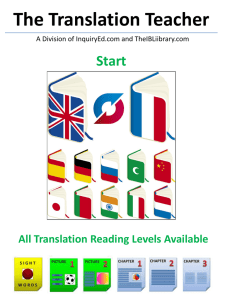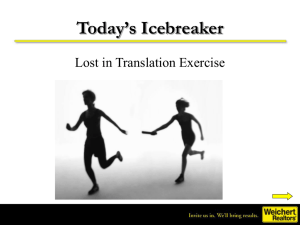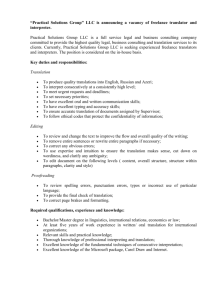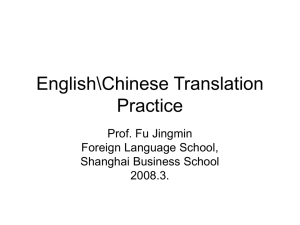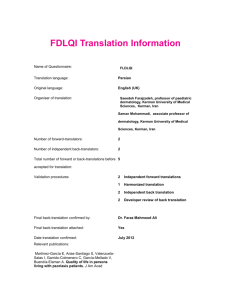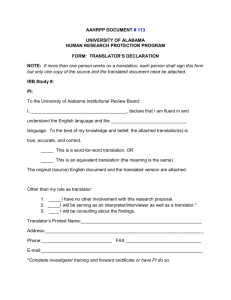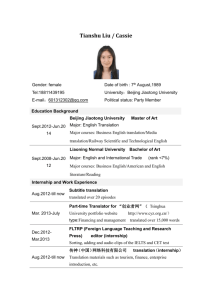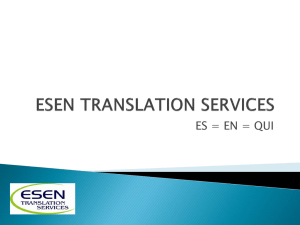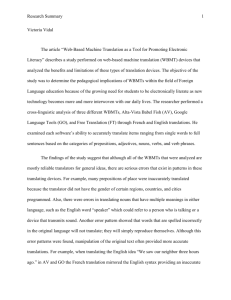November 4, 2013 - Literacy Research Association
advertisement
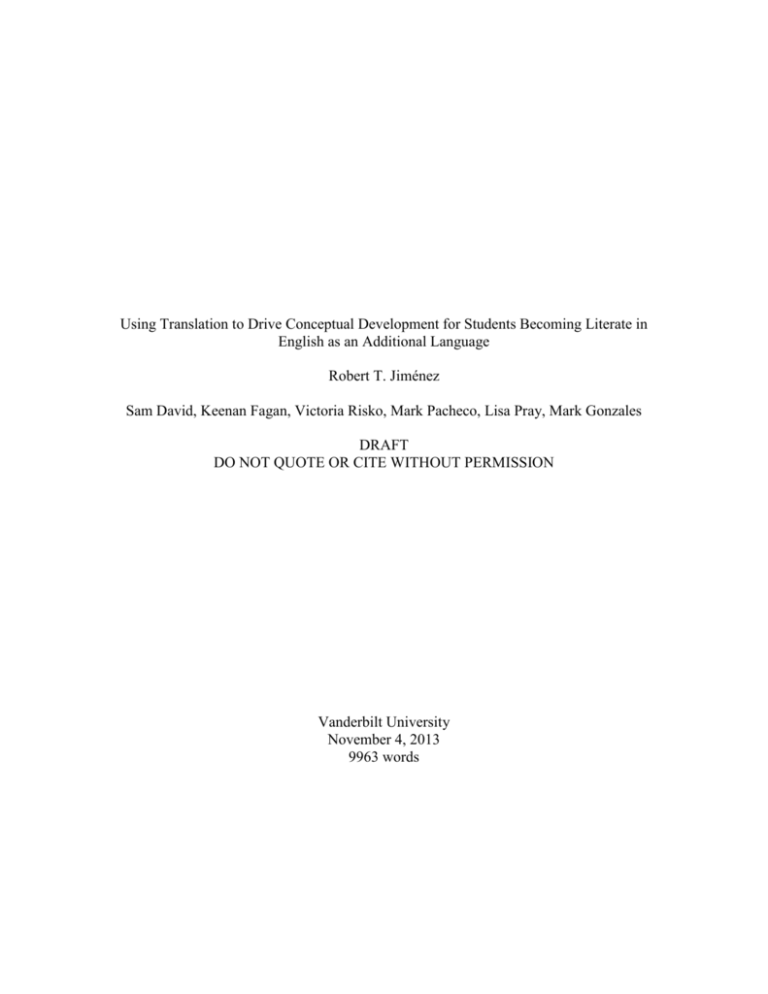
Using Translation to Drive Conceptual Development for Students Becoming Literate in English as an Additional Language Robert T. Jiménez Sam David, Keenan Fagan, Victoria Risko, Mark Pacheco, Lisa Pray, Mark Gonzales DRAFT DO NOT QUOTE OR CITE WITHOUT PERMISSION Vanderbilt University November 4, 2013 9963 words Abstract The purpose of this paper is to demonstrate that ELL (emergent bilinguals’) students’ comprehension of English texts, as well as their emergent conceptual understandings about language and literacy, become much more visible when they engage in the activity of translation. This preliminary research study sought to formulate an instructional approach (TRANSLATE: Teaching Reading And New Strategic Language Approaches To English learners) focused on using translation to improve reading comprehension. Middle school students who were described by their teachers as struggling readers were asked to work collaboratively and use various strategies to translate key excerpts from their required English literature curriculum into Spanish. Analysis of students’ statements, decision making and interaction indicated that students’ conceptual understandings about language played an important role in their learning. Finally, we describe refinements to our instructional approach focused on making conceptual growth a specific goal of instruction. Using Translation to Drive Conceptual Development for Students Becoming Literate in English as an Additional Language Much research on the literacy development of students learning English as a second language has focused on why this population struggles to learn English, and how to make English literacy instruction more “accessible and comprehensible” (cf. Goldenberg, 2008). Existing research says little about how emergent bilinguals use their linguistic resources in two languages to support their comprehension of English language texts (see Cummins, 2000; Orellana, Reynolds, Dorner & Mesa, 2003; Orellana & Reynolds, 2013; Valdés, 2003 as important exceptions). Furthermore, it does not specify how students learning English develop conceptual understandings of literacy nor does it have much to say about how they learn to reason about text meanings. More focus on how bilingual students develop conceptual understandings about language and apply them to the specific task of comprehension of English language texts could point toward new instructional approaches to facilitate literacy achievement among students learning English. In this paper, we report on an instructional approach (TRANSLATE: Teaching Reading And New Strategic Language Approaches To English learners) in which we asked grade 7 middle school students to translate carefully selected excerpts from grade appropriate literature. Using sociocultural understandings of how young learners become literate in a second language, we observed how our participating students drew on their cultural and linguistic knowledge to derive meaning and use information found in written text as they engaged in the process of translation. Based on these observations, we revised and refined our initial instructional theory for integrating students’ conceptual understandings about language to improve their comprehension of English texts. Theoretical Framework Our understanding of the concept development of students learning English is influenced by conceptual change paradigms explored in science education, theories that advance bilingualism as an attribute influencing conceptual change, and theories from applied linguistics that frame translation as an activity that requires active engagement with language at a conceptual level. Conceptual development in science and language In science education, learning has become synonymous with conceptual change and growth (Craig, Nersessian, & Catrambone, 2002; Lehrer, Schauble & Keith, 2006, p. 371). Students come to school with naïve or intuitive concepts about natural phenomena that exert a powerful influence on their ability to learn disciplinary scientific concepts. For this reason, researchers have dedicated a great deal of effort toward discovering and describing the nature of students’ naïve theories. For example, diSessa (2004) has argued that children’s uninstructed ideas about physics consist of “hundreds or thousands of inarticulate explanatory primitives, which are activated in specific contexts and, as a whole, exhibit some broad systematicity, but are not deeply systematic enough to be productively described individually or collectively as a theory” (p. 846). In diSessa’s view, children subconsciously internalize explanatory concepts for specific experiences they have had with natural phenomena. These differ from “scientific theory” in that they tend to be tacit and context-dependent; that is, they have not been abstracted from individual experience and articulated as a universal rule or hypothesis. Science educators view these understandings as the ‘bits and pieces’ of conceptual understanding that, given adequate instruction, appropriate materials and information, and relevant experiences, can form more disciplinary-like understandings (Clark, D’Angelo & Schleigh, 2011; diSessa, 1988). O. Lee (2005) has applied this perspective to bilingual students, recommending that science educators leverage students’ cultural and linguistic knowledge. We see the understandings concerning language and literacy held by students learning English as similar to, but not entirely the same as, the naïve or intuitive concepts about natural phenomena described by science educators. Emergent bilinguals bring many different ideas about language and bilingualism into schools. These ideas are rooted in what they know about their first language as well as what they have experienced and learned about English. They thus bring with them highly context-dependent, or as Vygotsky (1978) called it, spontaneous concepts about language that they reference to complete linguistic and academic tasks. While these spontaneous concepts about language may be highly developed, they tend to be unconscious and unarticulated. That is to say, while even emergent bilinguals may be capable of extraordinarily complex linguistic tasks across two languages (cf. Valdés, 2003), they may not be able to describe the system of rules that govern this activity. Lee (2007) calls this tacit knowledge and recommends that teachers make these understandings more explicit. We would add that students use this tacit knowledge to solve problems and that their problem-solving activity can be examined to identify the elements and active components of their spontaneous concepts about language. These understandings and problem-solving approaches can then be used as the basis for instruction designed to construct more disciplinary-like understandings of language and literacy. Like science educators, we believe these disciplinary understandings are developing when student thinking shifts to broader, more theoretical conceptualizations of language and its uses. Notions of conceptual development have not typically been a central focus for the field of literacy research. Though the need for deeper conceptual understanding is recognized in some research on metacognition and metalinguistic awareness (e.g. Hacker, Dunlosky & Graesser, 1998), a significant amount of literacy research has focused on helping novice readers attain higher levels of word recognition ability, larger vocabularies, fluency while reading and comprehension skills (August & Shanahan, 2006; Snow, Burns & Griffin, 1998). While not de-emphasizing the need for novice readers to acquire the skills and abilities identified by the National Reading Panel, it seems reasonable to assume that integrating discrete reading skills and strategies into coherent and robust theories of language is also important. For students in the process of learning an additional language, deeper and more coherent understandings of how written language operates, how languages function as rule governed systems, and how bilingualism encompasses possibilities for enhanced understandings are especially worthwhile outcomes. To achieve these outcomes, we begin with basic research into the conceptual understandings about language that students bring with them into the literacy classroom. Conceptual development and bilingualism Given the theoretical position we have mapped, it is not surprising that theorists have identified bilingualism as an attribute that enhances conceptual development (Adesope, et al., 2010), especially when students use both their languages to solve problems (Kenner, et al., 2008). These researchers have also noted that bilingualism makes possible greater metalinguistic and metacognitive development (Tharp & Gallimore, 1988), and that translation is a key activity because it requires students to compare, reflect on, and manipulate their two languages (Malakoff & Hakuta, 1991). Theorists interested in conceptual change argue that a focus on meta-level understandings (metacognitive and metalinguistic) increases the likelihood of growth and change (Bransford & Schwartz, 1999). Thus, we have hypothesized that by asking students to engage in translation, they will gain fuller metacognitive and metalinguistic awareness of how language functions. Furthermore, we theorize that translation focuses student attention on English text in ways that facilitate careful, dialogical reading and thus, greater understanding. Translation as a window to students’ conceptual understandings about language Fundamentally, translation is a creative activity designed to facilitate and enhance communication between speakers of different languages. Hall, Smith and Wicaksono (2011) examined the demands placed upon professional translators. They argue that translators need to possess grammatical competence and fluency in the relevant target and source languages, access to vocabulary in relevant professional and cultural domains in both languages, explicit metalinguistic knowledge of both languages’ grammars and areas of grammatical overlap, knowledge of pragmatic routines through which the source and target languages map communicative intention, knowledge of styles, genres, registers and dialects in both languages, literacy in both languages, and knowledge of translation theory. While full command of all of the preceding may be a rare achievement, we consider Hall, Smith and Wicaksono’s sketch as broadly representative of the disciplinary knowledge necessary to translators. Because translation is not simply the substitution of words from one language to another, we expect that students will engage in an activity that requires them to analyze source language texts for initial understanding, deal with semantic difficulties, contend with issues requiring word selection, engage in grammatical analysis and reformulation of acceptable syntactic constructions, and consider many of the other issues mentioned by Hall and his colleagues concerning pragmatics, styles, genres, registers and dialects. Thus, students in the process of learning English display cultural and linguistic understandings during the activity of translation. They do so by asserting and justifying translation choices in collaborative interaction with other students, and (less frequently) by making metalinguistic and metacognitve comments about translation, bilingualism and biliteracy. Considering this, our research questions for this project were: 1. How do emergent bilinguals use their linguistic knowledge in two languages (e.g., lexical, semantic, syntax) to translate texts and construct meaning? 2. What broader conceptual understandings (including meta-level comments) concerning language and literacy can we identify that emergent bilinguals bring or develop during the activity of translating? Methodology Research Design In this paper, we report the first phase of our plan for a long-term research activity that included piloting of our instructional approach. We entered our research site with a local instructional theory about the ways that students in the process of learning English interact with and comprehend written materials in their second language. Applying qualitative coding procedures, we frame our analysis around translation theory (Hall, Smith and Wicaksono, 2011) to describe our students’ use of linguistic information in two languages to support their reading comprehension. From this data analysis, we have constructed a more refined and improved instructional theory. Instruction We worked with 4 students at a local middle school over a combined period of one school year. In small groups, we conducted guided reading sessions (Fountas & Pinnell, 2001), modified to include the translation of conceptually and linguistically rich excerpts from the required English literature curriculum. We asked students to use a set of cognitive strategies (making connections, clarifying, summarizing, determining word meanings, accessing prior knowledge, rereading, predicting, translating strategies and evaluating) that were chosen to facilitate both translation as well as comprehension. A very brief outline of our instructional approach can be found in the following Figure 1. TRANSLATE Instructional Approach •Connect students to texts. Teacher guided discussion begins by asking students about personal experiences that reflect a main theme in the story. For example, prior to reading about a character having an argument with his mother over a major life decision, the instructor asked, “When was the last time you got mad at someone in your family?” •Independent reading. Students are asked to read a section of text silently and to identify its most important point, usually 2 to 3 pages from a novel. •Sharing of main idea from text. Students share (orally or in writing) what they thought was most important from the reading. Used to determine how well students comprehended the text before and after the translation activity. •Request translation. Teacher identities a short section of text for students to translate. As they become familiar with the goals of the activity, students may also be asked to select passages to translate. • Share and critique translations. Students are asked to discuss and explain their translation choices. • Reconnect translations to larger text. Students asked to discuss or write down how the passage might relate to the overall theme or characters in the story, and what new understandings they gained from the translation activity. Local demographics. Our research took place in a major metropolitan public school district in the South. The population of students learning English within the district has nearly doubled in the past 5 years, now comprising 22 percent of the total student population, more or less the same as the national average. Currently, the school district provides language support services to close to 10,000 students who come from 120 counties and 95 language backgrounds. One hundred and nine schools within the district serve students learning English. School Site. To date, we have worked in three different middle schools with 30 students. These schools all serve racially and ethnically diverse populations. In this paper, we report on data collected at one, Palmyra Middle School. We selected this site because we had sufficient time allocated for prolonged instruction. This school is located in a section of town known for its recent population growth—more than doubling in the past 20 years— and for its ethnic, linguistic, and racial diversity. Almost all students are from Latino or African American backgrounds and close to 90 percent receive free or reduced price lunches (See Table 1). Table 1: Palmyra Middle School 2010-2011 Enrollment 448 Female 46.7 Male 53.3 Asian 3.6 Black 27.0 Hispanic 45.3 White 24.1 Free and reduced price 88.6 lunch program Limited English 21.7 proficient Participants Our focal participants were four middle school youths who ranged in age from 12 to 14. These students constituted an intact group they stayed with the instruction through its entirety who were identified by their classroom teachers as native speakers of Spanish and ‘struggling readers’. All of our students had provisionally tested out of ESL classes, meaning that they had passed the state English proficiency exam, but still received accommodations in the mainstream ELA classroom. They were conversationallyfluent in English, and their levels of Spanish literacy ranged from rudimentary to expected grade level. Informal observations and formal language testing reveal that native language proficiency, both oral and literate, varied considerably. Students’ Spanish and English reading abilities were measured using the Basic Reading Inventory (BRI) (Johns, 2010) and the Spanish Reading Inventory (SRI) (Johns & Daniel, 2010). The BRI was administered by the students’ teachers in September 2010 and May 2011 and the SRI by our research team in March, 2011. Both assessments measure phonemic awareness, phonics, fluency, vocabulary and comprehension using leveled word lists and text passages. Once students’ reading levels were established by reading word lists, they read an appropriate leveled text while the test administrator created a running record and performed a miscue analysis. Students then retold the text and answered comprehension questions. Their reading levels were computed and the results are reported below in Table 2. Data sources Data sources for this paper consisted primarily of videotaped instructional interactions between instructors and participating students. These videotaped sessions 11 Table 2: Participating students’ Spanish and English Reading Levels Student Joyce Celina Karla Ronnie Spanish reading levels (by grade) Pre-Primer Primer 7th 4th English Reading level (fall) 6th 6th 6th 2nd English reading level (spring) 4th 7th 7th 5th were then transcribed and analyzed for evidence of how students interacted with the texts to make sense of them. Sessions were first transcribed for all English utterances and then a second transcriber went through and added all utterances spoken in Spanish. Then a certified professional bilingual transcriber checked all the transcriptions again by comparing them with the video data. Finally, these transcriptions were reviewed and refined by two of this paper’s authors. To the extent possible, verbatim transcriptions were created. On rare occasions, because of overlapping speech, unclear pronunciation or softly spoken statements, a word or phrase was not captured. We met with our student participants at Palmyra Middle School for a total of 30 half hour sessions over a period of 6 months. These sessions comprised a total of 15 hours. In addition, we created field notes of our time with the students and we conducted 2 semi-structured interviews with the group. Written translation artifacts were also collected and used to triangulate our understandings of interaction data. Data Analysis Our qualitative data analysis was ongoing throughout the study using a constant comparative method (Strauss & Corbin, 1998). We followed an iterative process of reading and rereading the instructional and interview transcripts and our field notes. During our analysis, we met weekly as a research team engaging in a recursive process to 12 revisit and refine codes we generated. In these meetings we presented data and our interpretations of these data, inviting critique and additional analysis. Possible patterns and themes across the data sources were recorded as theoretical notes that were used to guide the direction of the rounds of data coding. Our initial coding allowed us to observe all instances where students’ experienced comprehension or translation problems. These instances provided unique insights into student thinking. We then applied open coding to identify patterns of students’ work around their difficulties and axial coding for a more focused analysis of students’ use of linguistic and informational cues to resolve their comprehension or translation difficulties. This work resulted in categorizing all of our data into four domains. These included comprehension, translation, bilingualism and instructional moves. Our axial coding led to a refinement and synthesis of categories of language cues used by the students and that are used to report our findings. During our refinement of codes and categories representing linguistic and informational cues, we made connections between the data and our research questions, theoretical frameworks associated with translation activity, and research on bilingual learners. A theoretical frame for translation activity, advanced by Hall, Smith and Wicaksono (2011), provided the broad parameters of what translators need to know in order to carry out their professional activity. They include grammatical competence and fluency in the relevant target and source languages, explicit metalinguistic knowledge of both languages’ grammars and areas of grammatical overlap, access to vocabulary in relevant professional and cultural domains in both languages, and knowledge of pragmatic routines through which the source and target languages map communicative intention. Meaningful codes used for this analysis 13 included syntax, semantics, lexicon, knowledge of Spanish, knowledge of language, and language as a mental tool. We adapted the aforementioned parameters for their fit with our data. We therefore have organized our findings to represent bilingual lexical knowledge, syntactic knowledge, and semantic understandings of both languages. We believe that this organizational structure best addresses our two research questions that focus on students’ use of linguistic resources and represents their movement toward more disciplinary (or conceptual) understandings of language. Findings The data presented in this section address our two research questions. Throughout our reporting of findings, we discuss how students drew on their two languages to reason about the texts they read. They employed their “spontaneous” conceptual understandings about lexicon, syntax and semantics to create their target texts and in the process signaled how they navigated texts, drew inferences and generated questions, making possible deeper levels of conceptual development. The Role of Bilingual Lexicon in Translation In this excerpt1, the students have just read a chapter from Sandra Cisneros’ The House on Mango Street (1984), and the teacher is leading a discussion focused on their initial understanding of the text. The excerpts in this paper have been edited for clarity, primarily by removing indications of overlapping talk. Transcription conventions include: Parentheses () indicate the authors’ translation of Spanish utterances Carats <> indicate descriptions of interactionally significant actions Brackets with ellipses […] indicate unclear speech; words inside brackets indicate the transcriber’s educated guess. Ellipses … indicate pauses Hyphens - at the end of utterances indicate an interruption Italics indicate words that were said with particular emphasis. 1 14 1. 2. 3. 4. 5. 6. 7. 8. 9. 10. 11. 12. 13. 14. 15. 16. 17. 18. 19. 20. Instructor 2: So her great grandmother was wild, didn’t want to stay in the house and wanted to be free. What happened to her? Celina: She got married. Instructor: She got married. And how’d that happen? Ronnie: Well, the only reason she got married is because the guy hit her in the head and took her home, or something like that. Instructor 2: Something like that. Karla: And they fall in love. Ronnie: Nuh-uh. She never forgave him. Instructor 2: She didn’t say they fell in love. Ronnie: See look. The story goes she never forgave him. Instructor 2: Let’s listen to this line, “Until my great grandfather threw a sack over her head and carried her off. Just like that, as if she were a fancy chandelier. That’s the way he did it.” Ronnie: See. Karla: Oh. Instructor 2: So what did he do? Karla: <Makes an ‘I don’t know’ face> Ronnie: Hit her in the head with aJoyce: Sack. Ronnie: Sack. Instructor 2: A sack. OK. You seem confused. Can you tell me what’s going on, Karla? Did she get hit in the head? Karla: <Unsure voice> Yes. Instructor 2: Let’s translate this line, “Until my great grandfather…” This translation event clearly depicts students’ misunderstanding of a key part of the Sandra Cisneros vignette, “My Name.” Both Ronnie and Karla seem convinced that the great grandfather has hit the great grandmother in the head. Hitting someone is much more destructive than throwing something over that person and represents an important misunderstanding. In the following segment, students work through their translation of a single word, sack, and in the process, they access a pair of synonyms from their first language alongside a pair of synonyms in English. 1. 2. 3. 4. 5. 6. 7. Karla: <Talking out loud to herself> Un que…uno sack…una bolsa…una… (A what..a sack..a bag…a…) Instructor 2: Yeah. Karla: Una, como… Ronnie: <To Karla> ¿Una que? (A what?) Karla: Un sack, un… Ronnie: Porque tiene la sack. Solamente una. (Because it has the sack. Just one.) Karla: <Deciseively> Una bolsa. (A bag.) <Continues writing> 15 8. 9. 10. 11. 12. 13. 14. 15. 16. 17. 18. 19. 20. 21. 22. 23. 24. 25. 26. 27. 28. 29. 30. 31. 32. 33. 34. 35. 36. 37. 38. 39. 40. 41. 42. 43. 44. 45. <Students work silently for 40 seconds> Joyce: How do you say sack? Ronnie: Una bolsa. Karla: Carried her out, like. Ronnie: Y la cargó afuera. (And carried her out.) Or like, like, afuera, like out, okay. <Karla laughs> I’m so confused. Karla: La cargo? Se la llevó. (He carried her? He took her away.) Ronnie: Yeah, porque se la llevó. (Yeah, because he took her away.) Karla: <Writing> Y- (And-) Ronnie: Se la llevó. (He took her away.) Instructor 2: So did you figure out sack? What word did you guys use for sack? Joyce: Bolsa. Karla: Bolsa. Instructor 2: Bolsa? Karla: No, es este, un… (No, it’s this, a…) Ronnie: Un costal. (A sack.) Karla: Costal! (Sack!) Instructor 2: Costan. What’s the difference between costan and bolsa? Ronnie: Like a purse. Una bolsa es una purse. Un costal es like something small. Or it can be big too. Karla: No. Un costal es something kind of big. Ronnie: Not big big. It depends on how big the bags are. Instructor 3: ¿Qué se lleva en un costal? (What gets carried in a sack?) Karla: I think like this. <K draws something on her paper> Es un costal. (It’s a sack.) Instructor 2: And the bolsa would be more like purse? Ronnie: Yeah. Karla: ¡O! Un costal no tiene uno gente y la bolsa sí. (Oh, a sack does not have people and a bag does.) Ronnie: Yeah. Joyce: Carried…how do you say carried off? Ronnie: Y se la llevó. (And he carried her away.) Karla: <Reading Ronnie’s translations> Hasta que me? (Until I?) Ronnie: Wait, oh! <Erasing and rewriting> Karla: <Laughing> Ronnie: <Laughing>It’s […] Karla: It’s in español (Spanish). Karla: <Pointing at Ronnie’s paper> Una costal? Ronnie: That’s [what it] is. Karla: Es un costal. Ronnie: O, me faltó la “o” (Oh, I forgot the “o”). Karla: Uno costal? No, es un costal (An costal, no it’s a costal). This translation event is an example of how translation focuses student attention on the finer distinctions of word meaning, particularly when they evaluate the merits of different words as candidates for their translation choices. Their discussion includes 16 thinking about whether costal and bolsa include a distinction in terms of the size of the bag referred to in the text. Costal, in Spanish, usually refers to a gunnysack of the type used to transport agricultural products. The students are correct to think of costal as typically referring to a large sack and the fact that they select this word is revealing in terms of their visualization. Bolsa can be translated as the word sack or bag and it also would have been an acceptable choice for this purpose. Once they resolved how to translate sack and completed their translations, the instructor checked to see if their understanding of the scene had changed: 1. 2. 3. 4. 5. 6. 7. 8. 9. 10. 11. 12. 13. 14. 15. 16. 17. 18. 19. 20. 21. 22. 23. 24. 25. 26. 27. 28. 29. Instructor 2: OK. Would one of you read please? Karla: Come on Ronnie. Ronnie: Hasta que mi bisabuelo se la lle- (until my great grandfather carry-). Karla: Tatarabuelo. (Great great grandfather.) Ronnie: Oh. <Hits her forehead> Hasta que mi tatarabuelo le aventó un costal arriba de su cabeza y se la llevó. (Until my great great grandfather tossed a sack over her head and carried her away). Doesn’t even make sense. <Instructor asks Joyce and Celina to read theirs out loud, but they don’t want to. Ronnie takes Joyce’s paper and reads it to herself> Ronnie: <Pointing at the paper> Ella tambien le puso eso. (She also put that.) Karla: <Reading Joyce’s paper> Hasta que mi tatarabuelo le aventó una costal...una costal <Ronnie and Karla laugh, Ronnie erases and rewrites> arriba sobre su cabeza y se la llevó. (Until my great great grandfather tossed a sack over her…a sack over her head and carried her away) Ronnie: I like hers <hands the paper back to Joyce>, except una. Instructor 2: When we were first talking about this sentenceJoyce: Oh, una! (Oh, a!) Instructor 2: Will you listen for a minute? When we were first talking about this sentence, you were saying that her great grandfather hit her in the head. Joyce: Yeah. Instructor 2: Is that what your translations say or is it a little different? Karla: Hasta que mi tatarabuelo…le tiró? (Until my great great grandfather…threw?) Ronnie: Yeah, le tiró. Karla: Un costal arriba de su cabeza. ¿Le tiró en su arriba? ¿Cabeza arriba? ¿Le tiró , aventó? (A sack over her head. He threw it on her over? Head up? He threw it, tossed it?) Joyce: It’s kind of the same anyways. Ronnie: Yeah. It’s the same thing. Instructor 2: It’s kind of the same? Ronnie: Yeah. Instructor: You think he hit her <gestures like swinging a bat> or what? Ronnie: Le aventó (he threw it over her), <gestures like dunking a basketball> like she hit. <gestures like hitting something with a hammer> Karla: Cause it says threw. Joyce: He threw. Karla: Threw. <gestures like throwing a ball> Instructor 2: He threw? Karla: Not hit her. <gestures like she’s hitting Ronnie> Ronnie: Oh I get it. It’s… Oh my gosh. 17 30. 31. 32. 33. 34. 35. 36. 37. 38. Karla: That’s what I said. Instructor 2: And what about this part, “threw a sack over her head?” Joyce: Le tiró… (He threw…) Ronnie: Un costal arri…ba… (A sack ov…er…) Joyce: Arriba de… (Over her…) Karla: Le aventó un costal arriba de su cabeza. (He tossed a sack over her head.) Ronnie: No, it’s over <waving her palm over her head>, like arriba (up, over). Celina: Por eso, arriba. (That’s why, up, over). Joyce: Aventó. (Tossed.) Interestingly, although their translations did not contain any reference to hitting, the students were reluctant to let go of their original interpretation. However, having students read their translations aloud seemed to shift their attention from word level problem solving to sentence level meaning. This in turn led students to revisit several words in their translations, struggling to revise both their comprehension and their translation to bring the two into alignment and create a syntactically correct translation. In the process they let go of the misconception that the grandfather had hit his future wife in the head, and focused their attention on the words “threw” and “over.” Karla questioned whether the better translation of “threw” would be “tiró” (to throw) or “aventó” (to throw). At times, the students seem to struggle with the conceptual understanding that different words can mean the same thing. They do note, however, that tiró and aventó can mean “the same thing.” The notion of a synonym takes on added salience in this instance. Again, this understanding is a meta-level statement dealing with the lexicon. A few turns after the above excerpt, the students use gesture to clarify that the sentence makes more sense if they envision the grandfather putting the sack onto her head rather than tossing it above her head. Of interest is that through the process of translation and through their interaction with one another, the students do come to the realization that the great grandfather threw the sack over the great grandmother’s head 18 rather than hitting her. Both Ronnie and Celina seem quite surprised when they realize how their own comprehension has changed as they translate this portion of text. Ronnie signals this insight when she says, “Now I get it, oh my gosh.” Translating seems to have been pivotal to this change of understanding as it required the students to engage in a rather careful reading of the source text. The Role of Syntax in Translation In this excerpt, the students had just read a passage from the book Brothers in Arms (Langan & Alirez, 2004) and picked out sentences that they thought were especially important to understanding the story. The teacher asked them to work in pairs to translate two sentences chosen by one of the students, from a paragraph in which the narrator describes the pictures of his dead brother that he sees around his house: “One of them was a tiny photo of Huero in his Little League uniform. I loved that kid.” Students began by working individually to write down a translation, calling out questions to the group as needed. The excerpt below shows how they foregrounded their understanding of syntax as they worked through one such challenge. 1. 2. 3. 4. 5. 6. 7. 8. 9. 10. 11. 12. 13. 14. Ronnie: Una de ellos (One of them)…Wait. What? How do you start it? Dice… (It says…) Karla: That’s what I wrote. Uno de ellos estaba una foto pequeña de Huero (One of them was a small photo of Huero). Joyce: Era una (There was). Ronnie: Era una foto (There was a photo). <nods> Joyce: Una era (One of them was). Because estaba (was), that’s just like- <shrugs> Ronnie: I don’t know, it was like in the past, pero en esa <pointing at the text> está pusiendo presente (but in this it is putting present). Karla: Pero es una foto (But it’s a photo). Ronnie: Pero es en el presente porque dice (but it is in the present because it says): “One of them was a tiny photo of Huero in his little…” Karla: Was. Oh yeah. Joyce: Guess I’m smart. Karla: Estaba, estaba es pasado (Was, was is the past) Celina: Was is past. Karla: Por eso estaba (That’s why estaba.) Ronnie: Oh, so you were right, because […], my bad. 19 15. Joyce: Estaba? 16. Instructor 3: ¿Cual es la diferencia entre estaba y era? (What is the difference between estaba and era?) 17. Karla: Era. 18. Ronnie: Era es el pasado y estaba (Era is the past and estaba)… 19. Karla: También (Also). 20. Instructor 3: También. ¿Pero son distintos, sí? (Also. But they are different, right?) 21. Ronnie: Sí. (Yes.) 22. Karla: Uh huh, palabras (words). 23. Ronnie: It just depends how you use it. 24. Karla: Yeah. 25. Joyce: So is it estaba ó era? 26. Karla: Whatever you want. Same thing. 27. Joyce: Era. As might be inferred, Spanish provides two different ways to express the English verb to be. Their use depends on the user’s intent and some constraints such as location, temporality or permanence. Which is to say, estaba would denote the location or condition of an object (eg. The photo was on the wall; the photo was dirty), whereas era would denote an essential characteristic of an object (eg. It was a photo), so in this case the use of era is the more correct choice. In this excerpt, Karla begins by reading her translation of the first part of the sentence (turn 2), using the word estaba to translate the English word was. Joyce (turn 3) suggests that era would be the better translation, leading to a series of meta-level statements (linguistic and cognitive) in an effort to determine the correctly conjugated verb. Ronnie (turn 6) asserts, incorrectly, that the important distinction between era and estaba has to do with past and present tense. Karla challenges the idea that estaba is present tense (turn 11), which leads Ronnie to reverse her position and agree, rather unreflectively, that Karla was right. In response, the instructor probes further on the difference between era and estaba (turn 16), which elicits a vague but accurate conceptual statement (turn 23) and the assertion that word choice in 20 this instance is up to the translator’s preference (turn 26). It is worth noting that, despite this assertion, three of the four students used era in their final written translations. It is not clear why Karla chose the word estaba as her translation of the English word, was. The students most certainly brought a wealth of situational experiences of when to use one or the other, but perhaps little metalinguistic knowledge of the reasons behind such choices. Of interest, looking across our data we saw students struggle with how to translate a form of the English verb to be on at least five different occasions. In addition to the ser and estar distinction, Spanish provides two forms of the past tense to choose from, either imperfect or preterite tense. Imperfect tense signals that an action did not have either a definite beginning or end. Preterite refers to completed past actions. Our participants discussed both which verb to use and whether it should be in the imperfect or preterite form. They seemed to use what they learned in their English language arts classes to label and think about how to go about creating their translation; but of course, English provides no parallel for thinking about these distinctions. Although they could create grammatical Spanish sentences with a fair amount of accuracy, they had trouble evaluating different translation choices when the applicable Spanish syntactic or lexical rules did not have English equivalents. On only one occasion did a student use Spanish to label a grammatical category, tiempo pasado, or past tense. We surmised that students were transferring their knowledge of English grammar to Spanish. These differences between the two languages provide interesting opportunities for instruction designed to help students better understand their two languages as well as language in general. Another interesting issue with this episode is that Ronnie makes explicit references to past and present tense, thus signaling her awareness of the importance of 21 parsing the source text correctly. She also returns to the source text when she notes, “Pero es en el presente porque dice (but it is in the present because it says), “One of them was a tiny photo of Huero in his little….” Clearly, the task of translating has foregrounded the importance of syntax for the students. They identify it, struggle with it, and despite the fact that their focus on past versus present tense was initially incorrect, they arguably develop better understandings of the text and potentially deeper insight into the importance of grammar. Just coming to the realization that translating (and by extension, reading comprehension) is often an exercise in problem solving would, in itself, be an important breakthrough in conceptual understanding. In this excerpt, students recognize the role of tense within grammatical structure and the importance of returning to the source text in order to problem solve. The Role of Semantics in Translation In this example, the instructor asked students to translate a passage containing idiomatic expressions (“Cause I feel like I’m being swept away. I’m over my head.”). In choosing texts for translation, we were especially interested in sentences that students may have misunderstood on their first reading, as well as sentences that could not be translated in a direct, word-for-word fashion. The following example shows how emergent bilinguals in the process of translating address the issue of conceptually opaque idiomatic expressions. 1. 2. 3. 4. 5. 6. 7. Ronnie: I’m over my mind. What? Instructor 2: I’m over my head. What on earth is he saying? Karla: I’m over my head. Estoy arriba de mi cabeza. (I’m up above my head.) <Celina, Karla & Ronnie laugh> Instructor 2: Does that make sense? Karla: No. Instructor 2: ¿Estoy arriba de mi cabeza? (I’m up above my head?) Ronnie: I mean that’s what it says. 22 8. 9. 10. 11. 12. 13. 14. 15. 16. 17. 18. 19. 20. 21. 22. 23. 24. 25. 26. 27. Karla: I know. Instructor 2: How would you say that idea? What idea do you think he’s trying to say? And how would you say that in Spanish? Karla: Like, estoy al tope de mi cabeza. (Like, I’m at the limit of my head.) Ronnie: Oh! Sí, porque cuando te cansas de algo dices, ‘Estoy hasta el tope’. (Oh! Yes, because when you get tired of something you say, ‘I’m at my limit.’) Karla: ¿Ya me tienes hasta el tope, verdad? (You’ve tired me out, right?) Ronnie: Yeah. Instructor 2: So how would you say that in Spanish? How would you make your translation say that idea? Have you ever felt like that? You’re over your head? Ronnie: Yeah, like I’m tired. Karla: You’re tired of something, and then you’re like […]. Ronnie:¡Estás arriba de mi cabeza! (You’re on my mind!) Instructor 2: So how would you say that in Spanish? Or how would your mom say that if she’s just so tired of everything and… Ronnie: Se me tienes más arriba de la cabeza. (You’ve got me up over the top of my head.) Instructor 2: …she’s over her head and doesn’t know what to do? Ronnie: Well my mommy says in English, so I don’t know. Karla: Estoy harta de mi cabeza (I’ve had it with my head.) <Laughs> Joyce: ¿Harta? (Had it?) Ronnie: But you need it! Karla: I know! Estoy… (I am…) Joyce: Arriba de mi cabeza. (Above my head.) Karla: <Laughs> That doesn’t make sense. The students begin by attempting a word-for-word translation, which results in a laughably nonsensical sentence in Spanish (turn 3). Interestingly, the students agree that this nonsensical translation is technically correct when Ronnie states, “I mean, that’s what it says.” This moment is key, as it is a signal to the second language user that he or she is dealing with an idiomatic expression. During a different session, Karla had described a character as “dandole el avión a su mamá” (giving the airplane to his mother). In other words, at least some of these students were familiar with idiomatic expressions in Spanish. It seems reasonable to believe that Karla recognized ‘I’m over my head’ as an idiomatic expression. Earlier, in response to an instructor prompt, she came up with an idiomatic expression to translate the source language. Her choice of “estoy hasta el tope” would probably better correspond to something in English like, “I’ve had it up to here,” 23 or “I can’t take any more.” The students could have stopped there, deciding as they had in previous translation episodes that they had come up with a sentence that “made sense” (i.e. was grammatically correct and semantically coherent in the context of the passage). Instead, they continued to play with the language, combining their original word-forword translation with the Spanish expression, and trying out other words with similar meanings. It’s possible that these students had not yet developed the concept that two expressions can be equivalent without having any of the same words, or that the instructor’s questions in turns 14 and 18 led them to reject their first (and best) idea for translating the expression. Even so, as they debriefed, Ronnie made the meta-level statement that “There’s a lot of ways you can do it (the translation) that makes sense.” Although idiomatic expressions were uniquely problematic for students to translate, they were particularly fruitful for providing insight into student thinking. Working on idiomatic expressions, students recognized semantic problems with a direct translation, thought about alternate meanings of words and word synonyms in English, made inferences about what the passage might be saying, related the English phrase to idioms in Spanish, and assessed the resulting translations for syntactic correctness and semantic fit. As such, these episodes made visible the cultural and linguistic understandings that students either brought with them or developed during the activity of translating. In addition, the students made several meta-level statements during their translating work that reflected their prior or developing understandings of the nature of translating, bilingualism and biliteracy. These understandings are an ideal basis for 24 constructing more robust theories about language. In essence, they were moving towards the generation of rules and hypotheses concerning language, translation and bilingualism. As part of this work, students negotiated over words, grammatical choices and idiomatic expressions, noting as they did so that their choices depended on what they most wanted to communicate. Issues of lexical equivalence and polysemy, as well as grammatical differences across languages were frequently raised because the activity of translating necessitates such decision-making. Finally, students often commented on their decision making as they reflected on, manipulated and constructed their translations of English text into Spanish. Discussion While students’ bilingualism has been theorized as a resource for supporting literacy and for developing understandings about language, there is little work that points to specific ways that two languages can be leveraged to drive conceptual development. Goldenberg (2006) argues that while emergent bilinguals might benefit from using the full range of their linguistic resources in literacy, there are few empirical studies that validate this claim. Our findings show that translation provides opportunities for students to deepen their understandings about language and texts at the lexical, syntactic, and semantic level. Our findings also highlight the parallel between the strategies that emerging bilinguals use during translation and comprehension strategies used by highly proficient readers. To be clear, we believe that teachers in mainstream classrooms do this kind of work – drawing on students’ spontaneous knowledge to build disciplinary conceptual understandings of language and literacy – but they generally do so using only 25 monolingual tools. TRANSLATE invites students to use their full bilingual toolkits (Gutierrez, 1999) during literacy instruction. In the process of our analysis, we inferred that students were working with what we are calling a three-text model of comprehension (see Figure 2). These three texts are the source text (literature assigned to students as part of their grade-level appropriate curriculum), their comprehended text (what they understood the source text to mean), and their target text (their translation of the source text). The comprehended text can be described as the student’s mental model of what the source text contains. This mental Figure 2 representation may be incomplete, it may include misconceptions due to gaps in the student’s lexical or syntactic knowledge, as well as inferences grounded in prior knowledge that are different from that which was assumed by the author of the source text. Because translation requires careful and purposeful reading, students engage in a 26 back and forth movement between the source text, the comprehended text, and their developing translation. This activity is remarkably similar to that of highly proficient readers as they construct an interpretation of the text they are reading. In other words, the creation of a translation parallels the creation of an interpretation of a text except that a translation is a much more concrete and visible object, particularly if it is written. By drawing students’ attention to the parallels, we see great potential to increase emergent bilinguals’ understandings of language in general, reading comprehension, and how it functions. Our analysis convinced us that our participating students either developed, or had opportunities to develop, deeper and more coherent understandings of how written language operates, how languages function as rule governed systems, and how bilingualism encompasses possibilities for enhanced comprehension. First, our student participants experienced multiple occasions when they could compare and contrast their two languages. They did this when translating specific vocabulary items. For example, as they thought about how to translate the word sack, they brought up the possibilities of bolsa and costal. These occasions provide students with a chance to reflect on the nature of vocabulary, specifically in terms of how the range of lexical meaning can be more or less equivalent between words in Spanish and English. As students read their translated texts aloud, their attention was drawn to larger text-level understandings, and thus to the important insight that words matter but only as part of larger efforts at communication. Students typically abandoned word-for-word translations as they read their work aloud, and that pushed them toward more coherent understandings of their source text. Similar 27 to the translanguaging activities described by García and Sylvan (2011), this allowed them to see bilingualism as valuable for comprehension. Second, we saw that as a result of translating, our participating students focused their attention on matters of syntax. They recognized its importance and they attempted to define and analyze it. Bilingual individuals often perform these activities in everyday life spontaneously, but by asking our participants to translate in a school setting, the importance of syntactic elements such as verb tense became a topic of group discussion. Students also could not help but focus their attention on those instances where English and Spanish grammar differ. These differences provided opportunities for asking questions about language in general, such as ‘are there different kinds of past events?’ and ‘can one of my two languages express ideas in more complex ways?’ Such activity pushed our participants to compare and contrast their translated text to the source text and they began to experience the notion that translation, and by extension comprehension, consists of multiple cognitive operations. This last realization, of course, needed to be identified and verbalized, but all of the elements for doing so were available and fresh in their minds. Our participants also made use of their bilingualism to try out various ways to reformulate the source texts they read and in the process they came to deeper understandings of how written language functions. For example, they made a variety of metacognitive and metalinguistic statements as they worked through the source texts such as “it depends how you use it” and you “change the words so that they sound better in Spanish.” Other statements such as “There’s a lot of ways you can do it that makes sense” showed that as students revoiced the English language texts into Spanish, they 28 become more aware of the structural elements of their two languages. By playing with language, as they did when trying to translate the notion of stretching or the idiom I’m in over my head, our participants literally enlarged their capacity to understand how different languages function and, as a result, how to better comprehend written texts. Implications for instruction TRANSLATE has as its goal to improve the reading comprehension of students who are learning English. To do this, we designed a set of activities in which students worked collaboratively and used various strategies to translate key excerpts from their required English literature curriculum (see Authors, for more detail on students’ collaborative interactions). We showed them how to identify key excerpts and then how to use the selected strategies to facilitate both translation as well as comprehension. In the process of our analysis, we determined that students’ conceptual understandings about language played an important role in their learning, and that the instructional approach could be improved by making conceptual growth a specific goal of instruction. In this section we suggest instructional moves that could be incorporated into future instruction. First, we concluded that students need to develop “coherent and comprehensive explanations” of how they think about the role of lexicon and syntax during translation. All of our participating students brought a good deal of tacit knowledge to the task of translating. We see this tacit knowledge as one of the components or bits and pieces of conceptual understanding of language held by our participants. It included understanding that words have multidimensional properties with respect to their meaning. Students seemed to have less explicit understanding about how the grammars of their two languages differed with respect to the verb, to be, ser and estar, and the two forms for 29 past tense. For instructional purposes, teachers could make these understandings more concrete and visible with graphic organizers like a venn diagram or a semantic feature analysis. The idea that the instructor would want to convey is that words in both languages have overlapping domains of shared meaning. At a later time, students could depict the similarities and differences between these and other items bringing to bear their knowledge of two languages. Similarly, we noticed the struggles our participants had when dealing with idiomatic expressions. When students find a sentence that does not make sense, and direct translation yields a nonsensical target text, students should ask themselves whether a phrase is meant to be taken at face value or whether it is a semantically opaque idiomatic expression. Helping students to develop a formal definition of idiomatic expressions also makes sense. Obviously, the instructor’s role is very important here, as the cultural knowledge necessary to understand the meaning of idioms is something that students can never acquire just by working with words on the page. One move that seemed to help was to encourage students to review their text level understanding of the passage and think about what idea the author may be trying to convey. The teacher, whether monolingual or bilingual, can direct students’ attention to appropriate sections in the text that might support their understanding, or they can provide a formal definition of the idiomatic expression. Finding ways to provide students with a set of flexible responses to text ought to provide students who are English learners a useful set of tools for determining meaning. In addition to helping students examine their tacit understandings about lexicon, syntax and semantics, we also need to find ways to help students conceptualize the 30 process of translation as a series of steps or strategies that impact their understanding of the source text. We believe that by sharing with students our observations about what they are doing, and asking them to explain what they notice about their work, they will become more aware of how they use their understandings of language to solve problems. For example, when the students worked to figure out the meaning of the word, swept, they shared what they knew collectively, they translated the word, and they described their understanding of the word using Spanish. These are generalizable activities that could be helpful whenever they encounter unknown vocabulary in either of their two languages. Helping the students to see the similarities between their translated text and their comprehended text could be a useful move for improving their reading comprehension. We also conclude that, above and beyond their specific understandings about lexicon or syntax, we need to pay special attention to metacognitive or metalinguistic statements that students make while translating. In the flow of goal oriented, collaborative work it can be very easy to miss when students articulate larger understandings about the rules that govern their language use or a relationship between two different languages. For example, Ronnie’s conclusion concerning the difference between the two words era and estaba that “It just depends how you use it,” was both partially correct and potentially profound. This metacognitive/metalinguistic insight merited special recognition for its usefulness, and it would be a good idea to collect comments such as these for later discussion. Ronnie’s understanding is really the first step toward a more precise description of how these two verbs differ and how Spanish differs from English. 31 Finally, we should note that we see these instructional moves that help students articulate, examine, and develop their conceptual understandings about language as taking place over an extended period of time. In our experience, it can take a few days or weeks for students to become comfortable with the collaborative translation activity. Each participant brings a different set of proficiencies in their two (or more) languages, which are intimately wrapped up with identities and ideologies. As such, there is often a period in which both students and teacher must negotiate roles and decide what it means to be involved in a multilingual activity in a traditionally monolingual space. Even so, an informed and adept instructor can begin to get students thinking metacognitively about what they are doing when they translate. By collecting these insights over time, eventually the group will have a large list of translation strategies and linguistic insights that can then become an object of inquiry in its own right. By developing better understandings of themselves as learners, as bilinguals, and as readers, they would undoubtedly grow conceptually across these three domains. Conclusion Until recently, children’s first languages have been viewed as merely a temporary support for attaining second language proficiency. This understanding has recently been challenged on both theoretical and empirical grounds. Cook (1999) argues that “L2 users have the L1 permanently present in their minds” (p. 202). Demonstrating that bilinguals process cognate vocabulary faster than non-cognates, Kroll (2013) also concluded that “bilinguals seem to have both languages active at all times …”(para. 3). These views suggest that rather than design instruction that requires linguistic apartheid, instructional approaches for students learning another language should encourage them to make as 32 many connections as possible between the two. We see value in recognizing, affirming and recruiting all of students’ language resources for the purpose of reading comprehension. In fact, we designed TRANSLATE for teachers who must deal with the political realities of state laws that prohibit them from speaking their students’ languages (Authors). Such laws do not, however, prohibit children’s use of non-English languages. And because language is “the tool of tools” (Dewey, 1958, p. 168) with respect to thought and all human activity, we see great value in helping students learning English to think about and use it in ways that help them develop deeper insights into its nature. Finally, we see TRANSLATE as an approach that teachers in a wide variety of settings can employ: teachers with multiple language groups in their classrooms, and teachers who do not share their students’ languages. We look forward to developing the TRANSLATE instructional approach more fully so that it can be productively used by teachers and their students who are learning English. References Adesope, O. O., T. Levin, et al. (2012). "A systematic review and meta-analyses of the cognitive correlates of bilingualism." Review of Educational Research 83(1): 207-235. August, D., & Shanahan, T. (2006). Developing literacy in second-language learners. Mahwah, NJ: Lawrence Erlbaumn Associates. Authors, a, b Bransford, J. D. and D. L. Schwartz (1999). Rethinking transfer: A simple proposal with multiple implications. Review of Research in Education. I. Nejad and P. D. Pearson. Chapter 3, 24: 61-100. Clark, D. B., D'Angelo, C. M., & Schleigh, S. P. (2011). Coherence and understanding of force in the Philippines, Turkey, China, Mexico, and the United States. Journal of the Learning Sciences, 20(2), 207-261. Cook, V. (1999). Going beyond the native speaker in language teaching. TESOL Quarterly, 33(2), 185-209. Craig, D. L., Nersessian, N. J., & Catrambone, R. (2002). Perceptual simulation in analogical problem solving. In: Model-Based Reasoning: Science, Technology, & Values. 167--191. Kluwer Academic / Plenum Publishers, New York.; Cummins, J. (2000). Language, power, and pedagogy. Clevedon, Great Britain: Multilingual Matters. 33 Daily Science. (Producer). (2013) Think twice, speak once: Bilinguals process both languages simultaneously. Science Daily. Retrieved from http://www.sciencedaily.com/releases/2013/09/130910121521.htm, October 7, 2013. Dewey, J. (1958). Experience and nature (Vol. 1). New York, Dover. diSessa, A. A. (2007). Changing conceptual change. Human Development, 50, 39-46. diSessa, A. and B. L. Sherin (1998). "What changes in conceptual change? ." International Journal of Science Education 20(10): 1155-1191. Dreyfus, C. (2011). The bilingual advantage: Ellen Bialystok. The New York Times. from http://www.nytimes.com/2011/05/31/science/31conversation.html. Fountas, I. C., & Pinnell, G. S. (1996). Guided reading: Good first teaching for all children. Portsmouth, NH: Heinemann. García, O., & Sylvan, C. E. (2011). Pedagogies and practices in multilingual classrooms: Singularities in pluralties. The Modern Language Journal, 95(3), 385-400. Goldenberg, C. (2006). Improving achievement for English-learners: What the research tells us. Education Week, 25(43), 34-36. Goldenberg, C. (2008). Teaching English language learners: What the research doesand does not-say. American Educator, 33(2), 8-23, 42-44. Gutierrez, K., Baquedano~Lopez. P., & Tejeda, C. (1999). Rethinking diversity: Hybridiry and hybrid language practices in the third space. Mind, Culture, and Activity, 6(4), 286-303. Hacker, D. J., Dunlosky, J., & Graesser, A. C. (1998). Metacognition in educational theory and practice. Mahwah, New Jersey: Erlbaum. Hall, C., Smith, P., & Wicaksono, R. (2011). Mapping applied linguistics: A guide for students and practitioners. New York: Routledge. Johns, J. (2010). Basic reading inventory. Dubuque, IA: Kendall Hunt. Johns, J., & Daniel, M. (2010). Reading Inventory for Spanish Speakers. Dubuque, IA: Kendall Hunt. Kenner, C., Gregory, E., Ruby, M. and Al-Azami, S. (2008) Bilingual learning for second and third generation children. Language, Culture and Curriculum 21 (2), 120- 137. Kuo, L., & Anderson, R. C. (2008). Conceptual and methodological issues in comparing metalinguistic awareness across languages. In K. Koda & A. Zehler (Eds.), Learning to read across languages (pp. 39-46). New York, NY: Routledge. Kuo, L., & Anderson, R. C. (2011). Effects of early bilingualism on learning phonological regularities in a new language. Journal of Experimental Child Psychology, 111, 455-467. Langan, P., & Alirez, B. (2004). Brothers in Arms. West Berlin, NJ: Townsend Press. Lee, C. (2007). Culture, literacy, and learning. New York: Teachers College Press. Lee, O. (2005). Science education with English language learners: Synthesis and research agenda. Review of Educational Research, 75(4), 491-530. Lehrer, R. & Schauble, L. Sawyer, R. Keith (Ed), (2006). The Cambridge handbook of: The learning sciences. , (pp. 371-387). New York, NY, US: Cambridge University Press, xix, 627 pp. Malakoff, M., & Hakuta, K. (1991). Translation skill and metalinguistic awareness in bilinguals. In E. Bialystok (Ed.), Language processing in bilinguals. New York: Cambridge University Press. Orellana, M. F., Reynolds, J., Dorner, L., & Mesa, M. (2003). In other words: Translating or "para-phrasing" as a family literacy practice in immigrant households. Reading Research 34 Quarterly, 38(1), 12-34. Orellana, M. F., & Reynolds, J. F. (2008). Cultural modeling: Leveraging bilingual skills for school paraphrasing tasks. Reading Research Quarterly, 43(1), 48-65. Snow, C., Burns, M. S., & Griffin, P. (1998). Preventing reading difficulties. Washington DC: National Academy Press. Strauss, A. A., & Corbin, J. (1998). Basics of Qualitative Research (2nd Edition). Thousand Oaks, California: SAGE Publications, Inc. Tharp, R. G., & Gallimore, R. (1988). Rousing minds to life: Teaching, learning, and schooling in social context. Cambridge, England: University Press. Valdés, G. (2003). Expanding definitions of giftedness: The case of young interpreters from immigrant communities. Mahwah, NJ, Erlbaum. Vygotsky, L. S. (1962). Thought and language. Cambridge, MA: MIT Press. Vygotsky, L. S. (1978). Mind in society: The development of higher psychological processes. Cambridge, MA, Harvard University Press. 35
